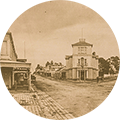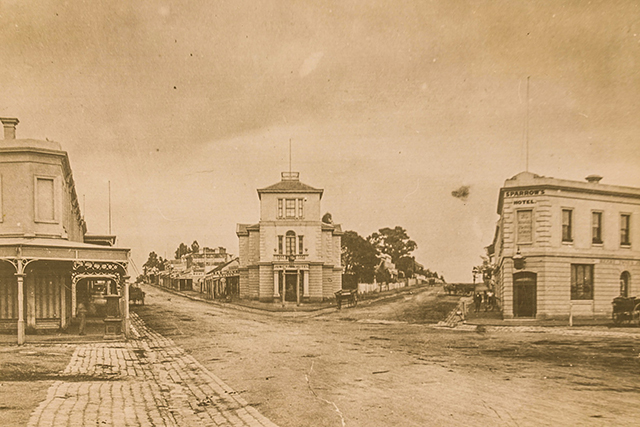From the beginning, St Kilda Junction was a gateway to St Kilda and the surrounding area. Its early life from the 1840s was a time of steady but dramatic change. The Junction played a pivotal roll in the settlement and development of the St Kilda village and the transformation of the environment from a natural to an urban landscape.
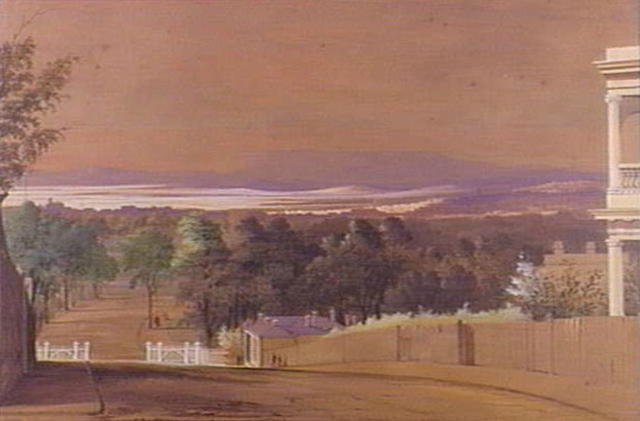
Looking from the Junction towards Barkley and Princes Streets (1862)
This view illustrates the built environment beginning to encroach on the natural landscape
When the European settlers first arrived they did not find a pristine landscape devoid of people. The Yalukit-willam (clan of the 'Boon wurrung' people) and their predecessors had inhabited the land for thousands of years. The territory of the Boon wurrun when the first settlers arrived extended over the Mornington Peninsula the catchment area of Western Port Bay and the coast strip of Port Phillip Bay. The St Kilda and Junction area however was in the specific territory of the Yalukit-willam clan. The Yalukit-willam clan were the inheritors of a society and cultural memory that was older than the landscape they inhabited and older than the coastal beeches, surrounding wetlands and 'park-like' environs that first attracted the settlers to the St Kilda area. This natural but worked landscape was husbanded, manipulated and managed by the Yalukit-willam for countless generations. The balanced interaction between the Yalukit-willam and their environments had achieved a level of sustainability and sophistication that was beyond the appreciation of most of the new settlers. However, the impact of the new settlers on the Yalukit-willam was overwhelming. By any metric whether physical, cultural, economical or emotional/psychological the impact of the new settlers on the Yalukit-willam people was devastating.
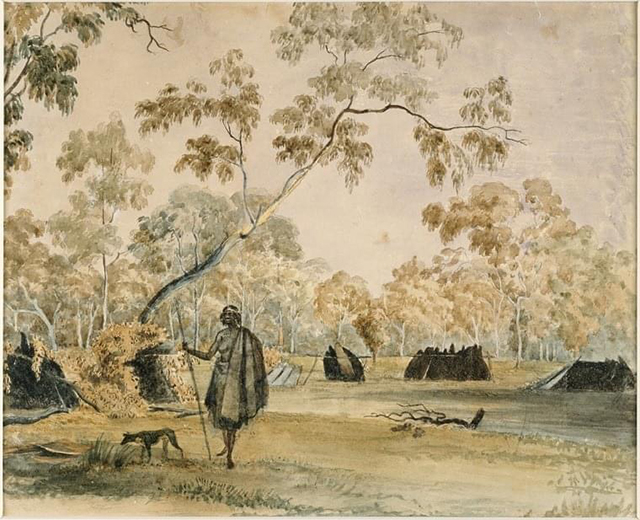
Camp on the south bank of the Yarra, sketched by John Cotton, c1845.
(Source: State Library Victoria)
The first European settlers recorded piles of shells left by the Boon wurrun people (presumably the Yalukit-willam clan) on the St Kilda foreshore and corroborees near the vicinity of the future St Kilda Junction. The first census of the original inhabitants made in 1839 recorded only eighty-nine Boon wurrun people by 1863 there were only eleven.1 The collapse of the Boon wurrun society and population is a sorrowful legacy of the European settlement. A relict and remainder of these first people still survives at the Junction; an old Corroboree Tree (river red gum) which stands vigilance in memory of the first people. The Victorian Field Naturalists' Club in the early 1950s lobbied for the tree's protection and to raise Melbourne’s aware of its significance. In July 1952 the St Kilda City Council had a plaque placed at the tree which stated: 'Aborigines of early settlement days congregated and held their ceremonies under and in the vicinity of this tree'.2 A lonely reminder of that the settlement of St Kilda was for the Yalukit-willam clan and all of the Boon wurrun people, a devastating event.
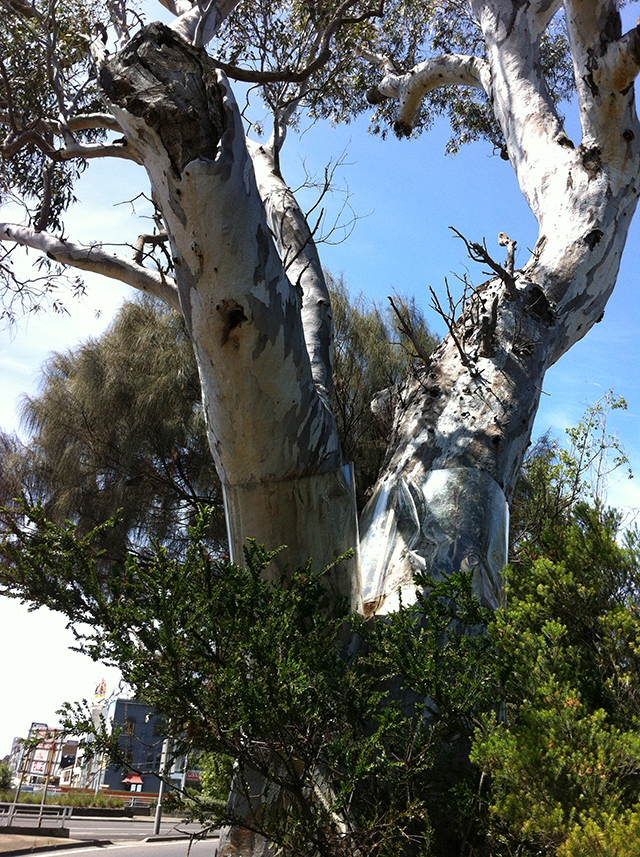
Corroboree Tree (River Red Gum) 2012
By 1847, a lot of clearing had taken place but there were still significant areas of native vegetation; there were a few small houses and some larger residences in the St Kilda area.3 The Junction Hotel was an early addition to the Junction area, opening for business in 1853.4 This hotel located in its prominent position was destined to be a local icon for generations.
The discovery of gold in 1851 resulted in an explosion of population as people from all over the world flocked to Victoria seeking their fortune. Gold changed everything in Victoria and St Kilda was no different, rapid change occurred in the area and the Junction was an artery feeding this change. There was a demand for new land, a need to escape the squalidness of Melbourne, a desire for clean fresh ‘healthy’ seaside air as well the commercial opportunity to make money. The 1850s and 1860s saw the accelerated development of urban infrastructure and institutions in the St Kilda area and the Junction was a focal point for this development. The natural environment was rapidly giving way to an urban landscape. A footpath was constructed from The Junction Hotel along the South side of Fitzroy Street in 1855 no doubt for the convenience of pedestrians. Substantial buildings appeared adjacent to the Junction and after years of agitation, in 1858 a police station opened at the Junction. The desire for a police presence gives some indication of a community concern over issues of law and order. Law and order was to be a reoccurring issue associated with the Junction. The police station also served as a location for he first St Kilda Council meetings held in 1857. The Police Station can seen located on the triangular intersection.
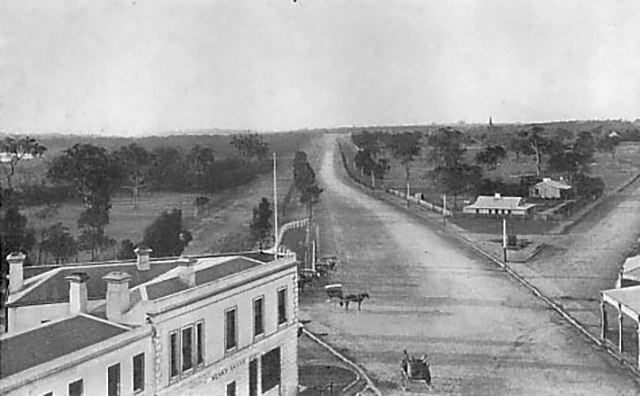
Looking from the Junction towards St Kilda and Punt Roads 1858
The Junction Hotel was a central locality for community activity. It provided entertainment such musical and vocal performances, a gathering place for the locals congregate and gossip and an opportunity for both locals and travellers to quench their thirst with an ale or two (or even more). The hotel also provided a premises for more formal community meetings and was the venue for the local literary club. Meetings for the literary club were in the reading room known as ‘The Athenaeum, St Kilda’.
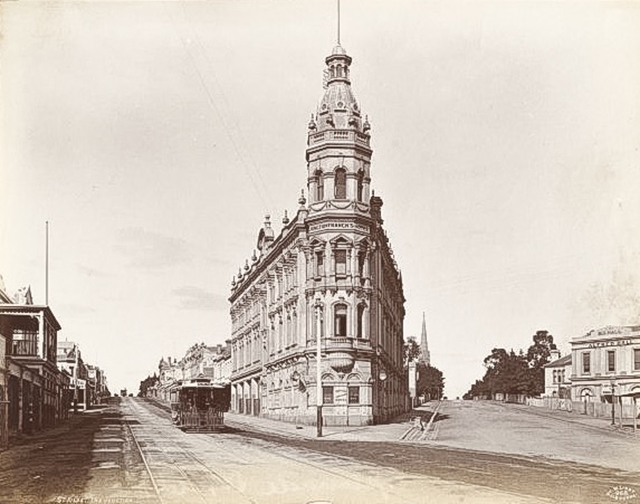
The Junction Hotel 1890s was a St Kilda icon up until its demolition in the early 1970s
From the 1840s to the 1890s saw a transformation of the landscape from natural to urban. The establishment and rebuilding of the Junction Hotel is a good illustration of this change. This photograph shows a rebuilt Junction Hotel, larger and grander than its processor in conjunction with the new transport technology of the time, a cable tram, running down High Street and Barkley Street on the left.
In the 1850s, a major infrastructure issue at this time was the supply of fresh water and was a major concern to local residents. In the beginning residents had to make do with capturing rain water which was supplemented with water brought in barrels from the Yarra River, at high prices which caused a lot of dissatisfaction. In 1855, the North corner of St Kilda Junction became the location for a water fountain and tank. This improved reliability but did not resolve community dissatisfaction at the cost due to the prices charged by the managing company. St Kilda eventually got a more satisfactory source of water but in the 1850s the Junction was known as much for its association with water supply as it was as a transport intersection.5
By the 1860s, St Kilda was a prestigious destination with many elegant homes.6 Between 1870 and 1890, the population of St Kilda dramatically increased and the land boom of the 1880s resulted in more development and the improvement of infrastructure. St Kilda Junction became a bustling intersection at the end of St Kilda Road, which was transforming into a grand boulevard linking the fashionable Fitzroy Street and Esplanade of St Kilda and the shopping strip of High Street.7
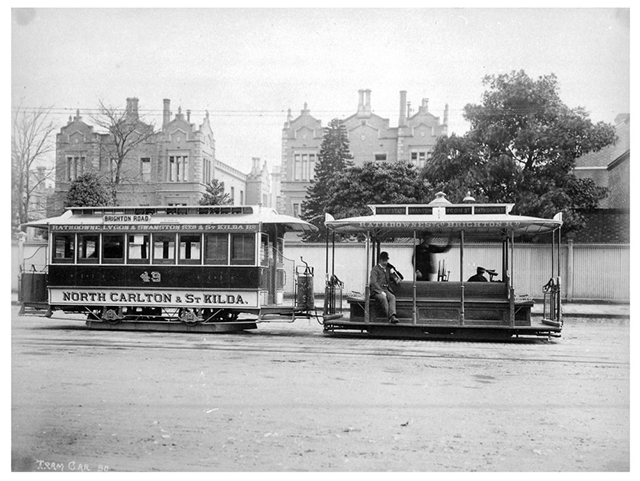
Cable Tram running on the St Kilda line 1905
Cable trams introduced in the late 1880s ran from the Central Business District down St Kilda Road to the Junction and then branched out to Fitzroy, High and Wellington Streets. The cable trams helped bring new range of visitors from other parts of Melbourne and assisted in transforming St Kilda from an elitist address to a more middle and working class holiday destination.8
The 1890s Melbourne and Victoria was hit hard by a period of economic depression. Many of the wealthy families of St Kilda lost much if not all of their fortunes. Many mansions converted to boarding houses; however, generally these were not the grim and over crowded boarding houses of the mid to late twentieth century but rather ‘upper class’ stylish guesthouses.9 St Kilda’s reputation as an elite residential address began to diminish in this period but it was still a desired location by many Melbournians to live and visit and the Junction played it part in these changes.
Footnotes
- A. Moo, St. Kilda: a general history, St Kilda, 1991, p. 1
- L. A. Longmire, The History of St Kilda: Volume 3 The Show Goes On: 1930 to July 1983, Hawthorn, 1989, pp. 161-162.
- J. B. Cooper, The History of St Kilda: Volumes 1 & 2 From Its First Settlement To A City: 1840 to 1930, Melbourne, 1931, Volume 1, p. 45.
- B. Aizen, 'Pots, Punks and Punters: a History of the Hotels of St Kilda and South Melbourne', St Kilda Historical Series no. 5, Balaclava, 2004, pp. 31-32.
- J. B. Cooper, The History of St Kilda: Volumes 1 & 2 From Its First Settlement To A City: 1840 to 1930, Melbourne, 1931, Volume 1, pp. 50, 70, 120-122, 247, 249.
- A. M. Longmire, The History of St Kilda: Volume 3 The Show Goes On: 1930 to July 1983, Hawthorn, 1989, p. ix.
- J. B. Cooper, The History of St Kilda: Volumes 1 & 2 From Its First Settlement To A City: 1840 to 1930, Melbourne, 1931, Volume 1, p. 142.
- S. O’Hanlon, 'Boarding Houses in Melbourne: A Twentieth Century History', Parity, vol. 22, Issue 5, June, 2009, pp. 11.
- A. M Longmire, The History of St Kilda: Volume 3 The Show Goes On: 1930 to July 1983, Hawthorn, 1989, p. ix.

